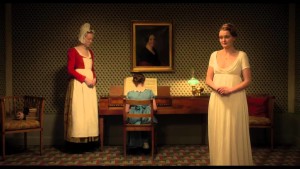 Review: One Afternoon Only
Review: One Afternoon Only
Amour Fou | Jessica Hausner | Austria | 2014 | 96 min
WUD Marquee Film Festival, Union South Marquee Theater, Sunday, November 15, 1:00pm»
Taylor Hanley argues that the dark humor and distinct visual style in Jessica Hausner’s Amour Fou provides a vivid critique of the Romantic era ideals of poet Heinrich von Kleist and Henrietta Vogel, who entered a suicide pact together in 1810.
I’m recently engaged, so of course I have fears of eventually being domesticated. I often worry that marriage will lead to a life stuck at home, or more specifically in the kitchen, and my hobbies will be limited to the Three C’s—cooking, cleaning, and maybe child bearing. Turning into a submissive wife is a concern of many young women once they get branded with a ring—and from watching Amour Fou this fear is totally justified. I became extra sensitive to any type of constriction, which my fiancé didn’t appreciate. But I guess that’s the point.
Amour Fou takes place in 1810 Berlin. I would describe the lead character, Henrietta (Birte Schnoeink), as…well…house broken. She knows her place. She doesn’t have opinions, and doesn’t have the voice to declare opinions even if she had them. I also assume she doesn’t pee where she isn’t supposed to.
Her submissive behavior doesn’t seem to be a result of her husband, Friedrich Louis Vogel (Stephan Grossman), who is a very nice man. Perhaps society is to blame, but the other women in the film are much more vocal and confident. Henrietta’s mother does not hold back in sharing her viewpoint, so Henrietta seems to put herself into this submissive place. When Henrietta hears singer at a party who has built a career for herself, she feels bad that the singer is burdened with the freedom to fail. She states outwardly that she is glad she doesn’t have to think for herself.
Henrietta’s self imprisonment sets up the eerie plot concerning her relationship with Heinrich von Kleist (Christian Friedel), the Romantic era poet and author of the controversial The Marquise of O. When Heinrich meets Henrietta, he is searching for someone to love him, and die with him.
Henrietta admires Heinrich’s work, and he admires her, so he asks her to die with him. After she finds out she is terminally ill anyway, she says yes. The rest of the film focuses on their struggle with whether or not they should continue with their suicide pact. New developments complicate the situation, like updates on Henrietta’s illness, or Heinrich’s being too picky about why Henrietta wants to kill herself. Overall, the two rarely seem in sync.
The humor, to the degree there is any, is very dry and subtle. I snickered at the explanation of her illness—when it was thought to be not serious—as being part of her “flow.” I laughed when they found out it was serious and they were told they couldn’t have intercourse—because they probably weren’t having sex anyway. But I’m not sure if others would laugh at the things that I found amusing.
The general lack of movement, by either camera or actors, made for very tight and restricted performances that were emphasized by the slightly-off period settings and the odd camera placements. The camera is static and often sits in a place that doesn’t let the viewer see everything they would like. Other times the camera is placed in weird locations, like in a corner or through a doorway.
In a scene where Friedrich is watching his wife dance, the camera oddly sits to fit part of him in the shot and only a section of the dancing that doesn’t include Henrietta. The shot frustrated me because I couldn’t see what he was looking at, but the set-up did reflect the awkwardness of the situation and heightened my awareness to what was going on. Eventually we realize that he is looking at his wife and another man; later he reveals to his wife that he thinks the poet likes her.
With no camera movement and restricted acting, the setting is prominent as strange, dark and wild at the same time. The mise-en-scene seems both era appropriate and weirdly modern and eye-catching. The décor adds to the creepy suspense as we wait to see if they eventually kill themselves. Decorative patterns make the restricted movement seem more controlled, and often the setting seems to engulf Henrietta.
The best scene of the film for me was towards the end: when Henrietta is laying still in bed, awake in the complete dark. All of the sudden she quickly sits up and stares straight ahead towards the camera. Ever since she left her home earlier that day with Heinrich she has seemed uneasy. Now here she is, staring, perhaps trying to decide whether she should go through with everything. It is almost as if she has finally realized that she merely went from following one man to following another. Is this the point she starts thinking for herself?
The film’s restrictions definitely made me want to revolt. Henrietta is so conventional, or so brainwashed, that even when she chooses to die she still is spineless and meek about it. This film was hard to watch at times, because of the slow pace and because I wanted to yell at the characters, but I am glad I watched it. Amour Fou distinguishes itself with its setting, its odd cinematography and decor, and its offbeat dialogue.